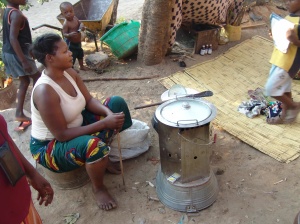
If indeed this works out, let’s hope we see more projects like this sprouting elsewhere.
Is there anyone on the ground who can tell us how meaningful this all this? Hello? Lusaka? hello…?
The stove in question, the Save80 cooking system, is well documented on the BioEnergy listserv and offers some outstanding energy delivery characteristics.
Here’s the blurb from the press release:
Climate protection by way of highly efficient biomass stoves
Together with its partner organisations, RWE (a major German utility) has launched a Clean Development Mechanism (CDM) project in Zambia. This is the first time a European energy company has been involved in a CDM project in southern Africa. The innovative cooking systems, which are financed by RWE, replace the environmentally damaging production and use of charcoal with sustainable biomass. In the first stage of the project, 1,500 local households in the capital city of Lusaka will be using these high-quality “Save80 cooking systems”. By the end of 2010, it is intended that 30,000 households in need and some 300,000 people will be using these innovative cooking systems. (Read the entire press release.)


My husband & I live in the Luangwa Valley for 8 months of every year & have done so since 2005.
We travel by road from our nearest town Nyimba to Lusaka once a month.It is heart-rending to see how more & more of the forests are decimated every year! What can we do?
Who is running your stove project in Lusaka? I would like to get in contact with them to find out how effective the introduction of the stove has been or whether the people have gone back to using charcoal.
Regards
Sylvia
I too am distressed at the destruction of trees to feed household cooking needs. I work at a medical facility where a large amount of clean cardboard packaging is discarded and was wondering whether recycled cardboard could somehow be made into brickettes for cooking on simple stoves.
I’m interested by the save80 system and would like to find out more.
Dear Susan,
Cardboard like many other solid biomass waste is made of naturally combustible materials that can be recycled into fuel. The main problem is cost. In developed countries, the principal use of biomass for fuel is through the generation of heat and electricity from municipal power plants. In the developing world, the problem is mostly in producing a product that is as good as charcoal and as cheap. That’s the challenge. Of course, if the price of charcoal in your local market is high, then barrier for entry may be lower. In Kenya, the price of charcoal is cheap, so it’s hard to come up with a solid biomass fuel that can compete. I’m not sure where you are located, though.
Rgds,
Kim
Evening I live in Lusaka Zambia I would like to purchase the cdm stove where Can I find your offices
Hi – sorry this is an older post, they do not seem to still be in business. I can refer you to Mattias at Emerging Cooking Solutions Zambia, which produces a pellet stove. You can reach Mattias by email, mattias@emerging.se